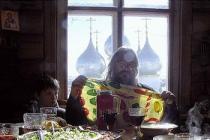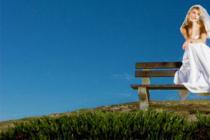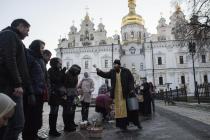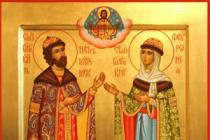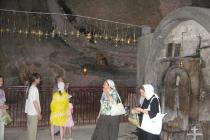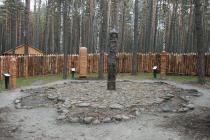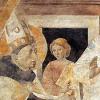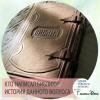When a person comes to church for the first time and sees the priest, what is remembered? a cross on the chest and a long beard. A look and a kind word in confession are remembered later, as a person becomes a church member.
Why do priests wear beards? Have believers thought about this? Hardly - well, they wear it and wear it, that’s how it’s supposed to be.
Let's talk about why this is the case.
At first there was...
Clipped poppy. This Byzantine tradition came to Rus'. What did she symbolize? Crown of thorns of Christ. The priests cut the crown of the head in a semicircle, but the rest of the hair was left long. This hairstyle is called "gumenzo". It existed until the 18th century; later this practice lost its necessity.
Already in the 17th century in Rus', priests combined two traditions: cutting the gumenzo and growing hair together with a beard. Thus, the top of the head was shaved smooth, and the remaining long hair was braided. The shaved part of the head was covered with a special cap - skufya. Why do Orthodox priests wear long hair? More on this in the next paragraph.
Where did this come from
The tradition of not cutting hair and beard may have appeared under the influence of Eastern monasticism. Monks do not cut their hair or shave. Gradually it spread to other Orthodox countries, including Rus'. The only exception is Western Christendom. There it was prescribed to cut hair and shave the beard, but this was done from a medical point of view - in order to avoid the spread of lice. Swimming in water sources, such as rivers, was prohibited. It was believed that there were too many infections in reservoirs.
In the East everything was exactly the opposite. Ablutions were performed daily, it was considered obligatory.
Another answer to the question of why priests wear a beard and long, neat hair is logical to consider the Biblical prescription. “Do not cut your head round and do not spoil the edges of your beard,” this line is from the Old Testament.

What about Catholics?
It’s more or less clear with Orthodoxy, and with its attitude towards long hair and beards among priests, too. What about Catholics? Why do Orthodox priests wear beards and Catholic priests do not? Among the clergy of this denomination there are many beardless and short-haired representatives.
The fact is that Catholics inherited the tradition of wearing hair and beards from the ancient Romans. Those, as mentioned above, were supporters of shaving beards and cutting hair for hygienic reasons.
Times have changed, but Catholics still have their traditions. The Russian Council of the Hundred Heads in 1551 recognized these traditions as heresy.

Why do priests wear a beard and mustache? Have you noticed that all priests have different beards? Someone has a neat, “professor” beard. And someone sports a long spade-shaped beard. There is an interesting opinion: priests who come from the intelligentsia prefer neat beards. And those whose ancestors were peasants wear majestic spade-shaped beards.

Father's appearance
In Russian churches they have long been accustomed to the fact that the priest must have a beard. This is his constant attribute, almost the same as vestments. Some people, especially young church ministers, can cut their hair. But the beard is inviolable.
Many people, even going to church for years, have no idea why priests wear beards and long hair. Meanwhile, everything is simple, as we managed to find out.

But let’s return to what an Orthodox priest should look like. For some reason, many people have an association: he is certainly fat, with gray hair and a beard. As for body type and hair color, these are just human speculations. Fathers are different. No, not black, white and red, but slender and not very slender, tall and short, gray and black-haired. But they all have a beard in common.
What does the church prescribe?
Why do Orthodox priests wear a beard? This is prescribed by the church. But a bearded priest, also with long hair, should look neat. Who would like a shaggy clergyman with long unwashed hair? Moreover, with an unkempt long beard? Of course, parishioners are unlikely to be drawn to such a priest.
What should a priest look like? Long hair is collected in a ponytail. Your head is always clear. The beard is neatly combed and has a shape despite its length. But taking care of your hair and beard should not go to extremes. Both unkemptness and excessive “lickiness” would be inappropriate.

The image of a priest in Orthodoxy
We found out why priests wear beards. What is he like, an Orthodox priest? He strives to be like Christ, for the priest is the earthly model for Christians. Isn't this one of the reasons for wearing long hair and a beard? Not a single icon depicts the Savior without a beard or long hair.

The priest wears a special vestment and cassock. The cassock is a kind of dress with very wide sleeves, usually black. But there may also be summer versions of this clothing - light ones. When it is very hot, wearing a black cassock is far from comfortable.
White clergy, that is, married priests, wear skufia - a special cap. The black clergy - monks - are dressed in cassocks and hoods. The hood is a tall black “hat” with a veil at the back. The blanket goes along the back and down to the floor. An indispensable attribute of monasticism, with the exception of a beard and long hair, is a rosary. The monks pray for them. Lay priests may also wear rosaries.
So, a representative of the white clergy looks like this:
Vestment and cassock.
A large cross on a massive chain on the chest.
Long hair and beard.
Sometimes - a prayer book in hand and a rosary.
Why do priests wear beards? We have already answered this question. Now let's talk about some interesting facts related to the unshavenness of priests and not only:
In an Orthodox church you can meet clergy without beards or with sparse hair. As a rule, these are young priests, and the absence of a beard is a temporary phenomenon.
It is believed that if a priest does not wear a beard, for reasons unrelated to his health, then he is ashamed of his service. They are wary of such priests, and parishioners try to avoid them.
Not only priests should grow beards. This is the duty of all Orthodox men, according to the instructions of the Old Testament about cutting hair and
Women in Orthodoxy are also prohibited from cutting their hair.
It is believed that hair is a person's cover at the Last Judgment. Everyone will be naked on it, and they will be able to hide their nakedness only under long hair.
In Orthodoxy there are no representatives of the fair sex among the clergy. This is not about the oppression of women. Suffice it to remember that the most revered Woman is the Virgin Mary. The fact is that God came into the world in a male form. The priest represents the image of Christ. A woman, due to her gender, cannot imagine His image.
Instead of a conclusion
The main purpose of the article is to tell the reader why priests wear a beard and often long hair. Familiarize him with the traditions in Orthodoxy, tell him about what an Orthodox priest is like.
Let's highlight the main aspects in the article:
For what reasons do priests wear beards and long hair? One of them is conformity to the appearance of Christ. He is depicted with a beard and hair.
The second reason lies in the eastern tradition of Orthodox monasticism that came to Rus'. Monks do not cut their hair or shave their beards.
An indication in the Old Testament is that a man does not need to shave his head or trim his beard.
In Catholicism it's the other way around. Catholic priests shave and cut their hair. This is due to ancient Roman hygienic standards, which have now become a tradition. In ancient Rome, beards and hair were required to be shaved to prevent the spread of lice. In addition, regular swimming in rivers was prohibited. In the East, daily ablution was considered obligatory.
What can I add? Short hair and a short beard hardly detract from the priest’s dignity as a priest. It is not the presence of a beard or hair on the head, but the way the priest approaches his mission.
Answers:
Tanya Sarbash(Ostrivnaya)
Having a beard is not a law. This is the church tradition of the Russian Orthodox Church. The custom of Orthodox priests wearing beards dates back to the Old Testament tradition. The Bible says this definitely: “And the Lord said to Moses: Speak to the priests, the sons of Aaron, and tell them... They must not shave their heads or trim the edges of their beard” (Lev. 21:1, 5). It was forbidden not only to shave, but to trim the beard, as this was part of pagan mourning rites.
Listopadnichek
Tradition. In the image and likeness of the source. As it is created, so it is worn.
Marina V
The priests observe the Biblical institution: the Old Testament. Third book of Moses. Leviticus. “Do not cut your head round, and do not spoil the edges of your beard. "(Lev. 19, 27)
TAL
not all young priests often do not have a beard
Vadim Mansurov
Answers:
Mikhail Morozov
Having a beard is not a law. This is the church tradition of the Russian Orthodox Church. The custom of Orthodox priests wearing beards dates back to the Old Testament tradition. The Bible says this definitely: “And the Lord said to Moses: Speak to the priests, the sons of Aaron, and tell them... They must not shave their heads or trim the edges of their beard” (Lev. 21:1, 5). It was forbidden not only to shave, but to trim the beard, as this was part of pagan mourning rites.
Pastor Alexander Lapochenko
At the Liturgy, the priest symbolizes Christ, so they try to match the image.
Tatyana \ Drana cat
trying to be like Christ at least outwardly
Midved the Blessed
I think that this is ordinary laziness according to the canons.
Vishnujana dasa
save money on the hairdresser
An Kar
Perhaps a tradition that goes back to the days when everyone wore beards and mustaches.
Loki Viking 1964
This is simply so that the mentally poor sheep of the flock of the Lord do not see their cunning and contented faces.
Oleg Nagorny
Well, some people like this tradition, because it distils, recalling the peculiar “Nazarite” priestly service... However, not all:
Andrey Tereshchenko
This is a BYZANTINE TRADITION. Catholics and Protestants don’t grow beards and Jesus has nothing to do with it, it’s strange that some “pastor” doesn’t know this
Verikostafrullahanistan$ky
Bogomaz
Andrey 8888888
God does not see people - he sees the light of people's souls... and what kind of beard is it - shaved or green, to be honest with his beard...
Olga Ruzavina
it's more glamorous
Denis Litvinov
you can’t force yourself to shave = an unpleasant thing and, in accordance with religion, they don’t force themselves = they don’t shave, but it’s easy to shorten their hair and many trim themselves without a hairdresser... Probably something like this...
Answers:
den!$
The tradition of wearing a beard goes back to Christ himself. There is a legend that the Lord was brought up in the Nazirite community - a branch of the Jewish religion. The Nazarenes were distinguished by the fact that they did not cut their hair, neither their beards nor their heads. This image was adopted by monastics in the first centuries of Christianity - in imitation of the Savior. Rus', when it adopted religion from Byzantium, adopted the church charter, originally written for monks. Along with the charter, the custom of not cutting hair came to us - at first only monastics followed this rule, then priests too. In almost all nations, a man without a beard was perceived as an immature youth. On the contrary, a man with a beard is a person who has life experience, which means he deserves respect and has authority. This, most likely, is the reason why our priests wear beards. A beard makes a clergyman stand out from other people. As a priest, I can say that wearing a beard and long hair causes certain inconveniences, but at the same time brings great benefits. Which one? You are always identified as a priest, they look at you as the Church of Christ. Realizing this, you try to behave in such a way that you do not disgrace the name of God with your behavior. But not all priests wear beards. If you see a priest without a beard, don't let it bother you. St. Nicholas, for example, was neatly tonsured, he even had a special gumenzo shaved on his head, which at that time was a sign of belonging to the priesthood.
Vladimir Kovalkov
save on soap
Answers:
Yulia Tarasenko
What happened before and what is now are two different things, the Nazarenes had long hair when they lived according to the Old Testament, they used to drink wine all the time, but now why is it a sin? Because earlier, firstly, wine was diluted several times with water, like 1/5, but I don’t remember exactly, secondly, they drank wine to disinfect their stomachs, and now to get drunk and be a drunken creature incapable of thinking and behaving normally. But as for a man’s long hair now, it’s definitely a shame. The Bible does not prohibit this, it only contains instructions and advice: “Everything is lawful for me, but not everything is beneficial.” So everyone chooses for themselves.
Linda 1
I guess not, since many priests have long hair
Birjuk
NO. What a stupid question.
DING
All priests and priests of Orthodox churches wear long hair.
his name is Legion
No. But at the same time, you cannot be like women - do a braid or ponytail.
drug drug
The Bible forbids. Isn’t it nature itself that teaches you that if a husband grows his hair, it is a dishonor for him,
Anton Kuropatov
Priests are allowed, they wear long hair and beards, like the Old Testament Nazirites.
Local Angel
Anastasia Belogortseva
no, clergy are prohibited from wearing short
Gendalf
only short skirts are not welcome….
I'm still Mikha
judging by the icon of Christ, this version has no meaning to live
Black Raven
It is forbidden to sin.
Andrew Kramer
Well, it’s like Jesus is depicted with long hair in icons. This question is just killing me. Jesus is an icon for believers, how can long hair be prohibited? Then the question is, and the church does not prohibit being bald. For some reason, no one asks this question. And what is the church, is this a law for you??? All churches are commercial organizations.
Lena
HAIR is an organ of perception and accumulation of subtle energies. The longer a person’s hair, the more spiritual power he receives, for this power nourishes all his bodies and shells. The Vedic scriptures say: “Cutting a man’s hair and shaving off his mustache and beard is the same as killing him.” But with special need and mastery of certain skills, a person can remove negative energy into his hair and cut it, thus freeing himself from the energies that interfere with his development - this is the meaning of the rite of “monastic vows.” The Slavs cut their children’s hair for the first time only when they reach the age of 7, and the cut hair is hidden under the ridge of the roof or matitsa (the main ceiling beam of the hut). If a child’s hair is cut before the age of 1, the development of his speech is suspended; if he is cut before the age of 7, the development of mental abilities slows down. A woman who has cut her hair is called karna (named after the goddess Karna, who is responsible for fulfilling the law of cause and effect) - that is, she is the one who was punished by Karna. Hence - “to rip off”. BEARD - hair on a man's face. Serves to accumulate vital and spiritual strength (“bo” - wealth, “roda” - belonging to a clan). In each varna they wear a beard in their own way: the witches do not cut their beard, but take care of it as the center of their spiritual power; knights wear short beards, as it is convenient for battle; Vesians wear full (large, but trimmed) beards as a sign of solidity, sedateness, and significance. Smerdas do not understand the true purpose of a beard and do not know how to use it, even if they grow it. Those who wanted to look like women began to shave.
Elena
The priests themselves sometimes wear long hair. But the Bible forbids this.
Answers:
Nadezhda Bogdanova
Complete information on the topic “why do priests wear beards” - all the most relevant and useful information on this issue.
Why do clergymen have beards?
Tanya Sarbash(Ostrivnaya)
Having a beard is not a law. This is the church tradition of the Russian Orthodox Church. The custom of Orthodox priests wearing beards dates back to the Old Testament tradition. The Bible says this definitely: “And the Lord said to Moses: Speak to the priests, the sons of Aaron, and tell them... They must not shave their heads or trim the edges of their beard” (Lev. 21:1, 5). It was forbidden not only to shave, but to trim the beard, as this was part of pagan mourning rites.
Listopadnichek
Tradition. In the image and likeness of the source. As it is created, so it is worn.
The priests observe the Biblical institution: the Old Testament. Third book of Moses. Leviticus. “Do not cut your head round, and do not spoil the edges of your beard. "(Lev. 19, 27)
not all young priests often do not have a beard
Vadim Mansurov
Mikhail Morozov
Having a beard is not a law. This is the church tradition of the Russian Orthodox Church. The custom of Orthodox priests wearing beards dates back to the Old Testament tradition. The Bible says this definitely: “And the Lord said to Moses: Speak to the priests, the sons of Aaron, and tell them... They must not shave their heads or trim the edges of their beard” (Lev. 21:1, 5). It was forbidden not only to shave, but to trim the beard, as this was part of pagan mourning rites.
Pastor Alexander Lapochenko
At the Liturgy, the priest symbolizes Christ, so they try to match the image.
Tatyana Koshka drana
trying to be like Christ at least outwardly
Midved the Blessed
I think that this is ordinary laziness according to the canons.
Vishnujana dasa
Perhaps a tradition that goes back to the days when everyone wore beards and mustaches.
Loki Viking 1964
This is simply so that the mentally poor sheep of the flock of the Lord do not see their cunning and contented faces.
Oleg Nagorny
Well, some people like this tradition, because it distils, recalling the peculiar “Nazarite” priestly service... However, not all:
Andrey Tereshchenko
This is a BYZANTINE TRADITION. Catholics and Protestants don’t grow beards and Jesus has nothing to do with it, it’s strange that some “pastor” doesn’t know this
Verikostafrullahanistan$ky
Andrey 8888888
God does not see people - he sees the light of people's souls... and what kind of beard is it - shaved or green, to be honest with his beard...
Olga Ruzavina
Denis Litvinov
you can’t force yourself to shave = an unpleasant thing and, in accordance with religion, they don’t force themselves = they don’t shave, but it’s easy to shorten their hair and many trim themselves without a hairdresser... Probably something like this...
The tradition of wearing a beard goes back to Christ himself. There is a legend that the Lord was brought up in the Nazirite community - a branch of the Jewish religion. The Nazarenes were distinguished by the fact that they did not cut their hair - neither their beards nor their heads. This image was adopted by monastics in the first centuries of Christianity - in imitation of the Savior. Rus', when it adopted religion from Byzantium, adopted the church charter, originally written for monks. Along with the charter, the custom of not cutting hair came to us - at first only monastics followed this rule, then priests too. In almost all nations, a man without a beard was perceived as an immature youth. On the contrary, a man with a beard is a person who has life experience, which means he deserves respect and has authority. This, most likely, is the reason why our priests wear beards. A beard makes a clergyman stand out from other people. As a priest, I can say that wearing a beard and long hair causes certain inconveniences, but at the same time brings great benefits. Which one? You are always identified as a priest, they look at you as the Church of Christ. Realizing this, you try to behave in such a way that you do not disgrace the name of God with your behavior. But not all priests wear beards. If you see a priest without a beard, don't let it bother you. St. Nicholas, for example, was neatly tonsured, he even had a special gumenzo shaved on his head, which at that time was a sign of belonging to the priesthood.
Vladimir Kovalkov
Yulia Tarasenko
What happened before and what is now are two different things, the Nazarenes had long hair when they lived according to the Old Testament, they used to drink wine all the time, but now why is it a sin? Because earlier, firstly, wine was diluted several times with water, like 1/5, but I don’t remember exactly, secondly, they drank wine to disinfect their stomachs, and now to get drunk and be a drunken creature incapable of thinking and behaving normally. But as for a man’s long hair now, it’s definitely a shame. The Bible does not prohibit this, it only contains instructions and advice: “Everything is lawful for me, but not everything is beneficial.” So everyone chooses for themselves.
I guess not, since many priests have long hair
NO. What a stupid question.
All priests and priests of Orthodox churches wear long hair.
his name is Legion
No. But at the same time, you cannot be like women - do a braid or ponytail.
The Bible forbids. Isn’t it nature itself that teaches you that if a husband grows his hair, it is a dishonor for him,
Anton Kuropatov
Priests are allowed, they wear long hair and beards, like the Old Testament Nazirites.
Local Angel
Anastasia Belogortseva
no, clergy are prohibited from wearing short
only short skirts are not welcome….
judging by the icon of Christ, this version has no meaning to live
Black Raven
Andrew Kramer
Well, it’s like Jesus is depicted with long hair in icons. This question is just killing me. Jesus is an icon for believers, how can long hair be prohibited? Then the question is, and the church does not prohibit being bald. For some reason, no one asks this question. And that the church is the law for you. All churches are commercial organizations.
HAIR is an organ of perception and accumulation of subtle energies. The longer a person’s hair, the more spiritual power he receives, for this power nourishes all his bodies and shells. The Vedic scriptures say: “Cutting a man’s hair and shaving off his mustache and beard is the same as killing him.” But with special need and mastery of certain skills, a person can remove negative energy into his hair and cut it, thus freeing himself from the energies that interfere with his development - this is the meaning of the rite of “monastic vows.” The Slavs cut their children’s hair for the first time only when they reach the age of 7, and the cut hair is hidden under the ridge of the roof or matitsa (the main ceiling beam of the hut). If a child's hair is cut before the age of 1 year, the development of his speech is suspended; if he is cut before the age of 7 years, the development of mental abilities slows down. A woman who has cut her hair is called karna (named after the goddess Karna, who is responsible for fulfilling the law of cause and effect) - that is, she is the one whom Karna punished. Hence - “to rip off”. BEARD - hair on a man's face. Serves to accumulate vital and spiritual strength (“bo” - wealth, “roda” - belonging to a clan). In each varna they wear a beard in their own way: the witches do not cut their beard, but take care of it as the center of their spiritual power; knights wear short beards, as it is convenient for battle; Vesians wear full (large, but trimmed) beards as a sign of solidity, sedateness, and significance. Smerdas do not understand the true purpose of a beard and do not know how to use it, even if they grow it. Those who wanted to look like women began to shave.
The priests themselves sometimes wear long hair. But the Bible forbids this.
In addition to external material attributes - vestments, the way of wearing a cross - Catholic and Orthodox priests are strikingly different in the tradition of shaving or growing facial hair.
Among Catholic church ministers, shaving the beard is not mandatory. Some fathers wear small beards if they so choose. But none of them have that huge, thick beard that is obligatory for any Orthodox priest. There are several reasons for this.
Image of Jesus
During the service, the Orthodox priest symbolizes the image of Christ, and the Son of God is traditionally depicted with a beard and mustache. In this way, the priests pay tribute of veneration and admiration to God. But the main reason is still the direct command not to cut your hair and beard, which is in the Bible. In the Book of Leviticus, the Lord commands Moses and all the people: “Do not cut your head round, and do not spoil the edges of your beard” (chapter 19, verse 27).
Orthodox Christians took this commandment literally. In Rus', it was sacredly performed not only by priests, but also by ordinary laymen. It was precisely this image of a man - with a long, untrimmed beard - that was considered handsome and decent for a believer. For this reason, the new fashion for a shaved face, which Peter the Great forcibly introduced, was met with hostility.
Roman traditions
A Catholic priest does not represent Christ during the service. He is rather equated with his parishioners. Catholicism is heavily influenced by Roman, more secular traditions. The ancient Romans, who finally adopted Christianity in a difficult struggle against pagan idols, considered shaving the face a mandatory hygienic procedure for any civilized person.
Bearded men were considered barbarians in ancient Rome. Roman legionnaires met such people in the northern lands, where they often went for new slaves and wealth. The noble Roman patrician always carefully looked after his face and certainly shaved off excess hair, so as not to become like commoners and slaves. This tradition was consolidated later in Catholicism. The clean-shaven face (and in some monastic orders, the head) of a priest is considered a special symbol of holiness.
In connection with the tradition of shaving the beard in the Middle Ages, an unusual ritual arose. In the 9th century, the sacred papal throne in the Vatican was rumored to be occupied by a woman. The legendary Pope Joan called herself John VIII. She felt such a strong desire for piety that she hid her true gender in order to lead the church. All the priests shaved their faces, so no one was surprised at the beardless and effeminate father of the church.
After a scandalous incident during one of the ceremonies, when the Pope allegedly gave birth to a baby, this shameful fact was forever erased from the history of the Roman Catholic Church. Whether all this was true or rumors is now difficult to establish. And yet, it was after that incident that the ritual of determining the gender of the future pontiff was established.
The applicant sat in a special Sella chair, in which a small hole was cut. The authorized holy father simply put his hand under the seat and literally felt for physical evidence of the masculinity of the future head of the church. In the case of Orthodox priests, such problems never arose. A thick or not very thick beard clearly indicated the gender of the priest.
Why does a priest need a beard and long hair?
Long hair for clergy is a tradition. Most likely, it came from the Orthodox East under the influence of monasticism. Throughout the Orthodox world, including among the Eastern Slavs, wearing beards and long hair among priests was the norm.In the Russian Orthodox Church, the tradition of clergy wearing long hair replaced another custom - cutting the hair at the crown of the head, which symbolized the crown of thorns of Jesus Christ. This tradition came to Rus' from Byzantium. There, the custom of cutting hair existed since the times of the early Christian Church, but was finally established in the 7th century (21st rule of the VI Ecumenical Council of 692). The clergy's hairstyle involved cutting the hair from above, on the crown, and cutting it from below “in a circle.” In Rus', the cropped crown of the clergy was called gumentso. The shaved part was covered with a small cap - skufya.
Since the 17th century, two traditions have existed together in the Russian Orthodox Church: not cutting your hair and cutting your hair. This is evidenced, for example, by Archdeacon Paul of Aleppo, who in 1656 traveled to Moscow with his father, Patriarch Macarius of Antioch: “ The hair on your head is(priests - d.I.I.) do not shave, except for the large circle in the middle, leaving the others long, as they eat b" [ Pavel Aleppo, archdeacon. The journey of the Patriarch of Antioch Macarius to Moscow in the 17th century. St. Petersburg, 1898. P. 97]. It is impossible to say with certainty how long the cutting of the crown was practiced, but by the 18th century. this practice was completely abandoned.
Probably, ever since the priests began to grow long hair, the latter became a subject of increased attention for them. So the Church was faced with the need to develop some recommendations regarding what should be the attitude of each individual priest towards his own hair. One of the sections of pastoral theology - the science of the moral qualities and duties of priests - speaks about the appearance of a priest, as well as about hair care.
The priest's hairstyle, like his entire appearance, should testify to his modesty and restraint. Shaggy, unkempt, dirty hair, as well as excessively groomed and styled hair in secular fashion, is regarded as unacceptable for the clergy. When taking care of your hair, you need to avoid extremes.
In the Russian church tradition, both a beard and long or elongated hair have been and remain distinctive signs of the Orthodox clergy, which is quite consistent with both liturgical vestments and the traditional perception of the clergy by the Orthodox people.
If a priest does not wear a beard and long hair not for health reasons, but deliberately in accordance with his desire, then people (not only believers) have a well-founded idea that the priest is embarrassed by his ministry and, in some way, is “disguising himself” .
Both the tradition of cutting the gumenzo and the tradition of letting shoulder-length hair have their bases, but none of them had the force of law. Appointment Paul to the Corinthians (1 Cor. 11:14-15) is not a law or rule that requires unquestioning execution, it is a custom corresponding to the era and culture of the first Christians in the East.
On my own behalf, I can only add: if a clergyman has already decided to grow long hair, then he needs to take care of it and listen carefully to the instructions given, for example, by Professor Archimandrite Cyprian (Kern): “Moderately trimmed hair, a trimmed beard and a moderately shortened mustache in no way cannot diminish the spirituality of the priest and give rise to the reproach of panache" ( Archimandrite Cyprian, professor. Orthodox pastoral ministry. St. Petersburg, 1996. P. 92)
Why do priests wear beards?
Should a Christian wear a beard? Why?
Should men grow a beard?
I kindly ask you to tell me if you know any sources on the Church canons that would indicate that men should grow a beard and hair and could not cut it. And what to do so as not to back down on this small issue, since parents are against a long beard and long hair.
God bless you for your answer.
Answer from Father Oleg Molenko:
Regarding growing hair for men of the non-holy class, I answered Demetrius (question No. 660) that growing long hair is dishonorable for a man.
Regarding the beard, it is dishonorable for any man to be shaved.
This pious tradition, which has its foundations in Holy Scripture, has been and is firmly preserved by the Church of Christ. A man's face without a beard was considered effeminate, which was allowed only to young men who had not yet reached maturity or who did not naturally have a beard. Myself.
The apostolic decree prohibiting the evil of barbering contains the following saying: “We must also not spoil the hair on the beard, or change the image of a person contrary to nature. Do not bare, says the law, your beards. For the Creator God made this (being without a beard) suitable for women, but He declared it obscene for men. But you, who bare your beard in order to please, as one who resists the law, will be an abomination to God, who created you in his own image” (Decree of the Holy Apostle. Publ. Kazan, 1864, p. 6).
Rule 96 of the 6th Ecumenical Council:
Having put on Christ through baptism, they vowed to imitate his life in the flesh. For this reason, for the sake of the hair on the head, to the detriment of those who see, disposing and removing with artificial weavings, and thus deceiving unconfirmed souls, we fatherly heal with decent penance, guiding them like children, and teaching them to live chastely, and, leaving the charm and vanity of the flesh, to.
Is it compulsory for Orthodox Christians (men, of course) to have a beard? Are there canonical decrees on this matter?
This is rather a tradition that was shaken by Peter the Great
God created it this way - let it grow, but shaving it is not a sin
The meaning of the beard in the religious beliefs of Russians of the 16th-18th centuries
In Christian art, the principle of verisimilitude was established very early, that is, the rule of depicting sacred faces not by guesswork, but by external bodily likeness. This approach of art to reality, bequeathed by legend, in some way tends towards portrait images. Only by the most detailed reproduction of the complexion and hair on the head, the finishing of the beard and eyebrows, even the expression of the gaze itself, could the artist achieve a complete likeness. The decoration of the beard and hair on the head was especially useful to the Byzantine miniaturists, from whom it spread and became established in ancient Russian icon painting, which.
However, the tradition of wearing a beard goes back to Christ himself. There is a legend that the Lord was brought up in the Nazirite community - a branch of the Jewish religion. The Nazarenes were distinguished by the fact that they did not cut their hair - neither their beards nor their heads. This image was adopted by monastics in the first centuries of Christianity - in imitation of the Savior. You may notice that Jesus Christ is always depicted in icons with a beard and long hair. (This refers to the image of Him at 30-33 years old.
Five reasons why a Russian man should wear a beard
Russian philosophers called the beard the fundamental virtue of the Orthodox Russian man. Spiritual poems and odes were written about “barbarous husbands,” and in the pre-Petrine era the razor was equated to a knife, which was used for operations to turn a man into a eunuch. So why should a Russian man wear a beard?
Beard as a Russian tradition
Since time immemorial, it has been customary for men in Rus' to wear thick, thick beards. And everyone knows that Peter I was the first to speak out against this tradition, declaring in 1698 a special duty that was imposed on everyone who wore a beard. Somewhat later, in 1705, this duty was divided into four categories. Each category corresponded to one or another class:
– 600 rubles a year were paid by courtiers, officials of various levels and city nobles;
– 100 rubles a year were given to the treasury by guests of the 1st article;
– 60 rubles per year were charged to merchants.
1. I don’t know where you, Alexey, got this from, but Canon 96 of the 6th Ecumenical Council says something else:
“Those who have put on Christ through baptism have vowed to imitate His life. For this reason, for the sake of the hair on the head, to the detriment of those who behold, who arrange and remove with artificial weavings, and thus deceive unconfirmed souls, we fatherly heal with decent penance, guiding them, like children, and teaching them to live chastely, and leaving the charm and vanity of the flesh, to the undying and blessed in life they constantly direct the mind, and have a pure abiding with fear, and through the purification of life, as much as possible, they come closer to God, and they decorate the inner person more than the outer person with virtues and good and immaculate morals; and let them not carry within themselves any remnant of depravity that came from the enemy. If anyone acts contrary to this rule, let him be excommunicated.”
This is probably a late addition about beards. ;)) And even if we really apply all the rules of the Ecumenical Councils to the modern one.
Tell us why some priests grow beards, while others trim or shave? Is this regulated somehow or is it just a matter of taste?
And the same question regarding the clothing of priests. I know that some wear robes, while others wear ordinary secular clothes. What is this connected with?
Hello, Artemy. You have good questions. The priest of the Orthodox Church is the bearer of the image of Christ. This should be expressed primarily in his spiritual and everyday life. This always happens, with rare exceptions - they, as you know, emphasize the rule. We all want to see a kind, attentive priest who cares about the salvation of every person. But the image of the Savior is also expressed in the appearance of the clergyman - in his appearance. It is known that Jesus Christ had a mustache and beard on His face. This is how the Lord is depicted on Orthodox (and not only) icons. For a priest, this is an example of appearance. The Savior wore long clothes. From here.
Long hair for clergy is a tradition. Most likely, it came from the Orthodox East under the influence of monasticism. Throughout the Orthodox world, including among the Eastern Slavs, wearing beards and long hair among priests was the norm.
The exception was the lands of the western part of Christendom. Roman tradition prescribed cutting and shaving. This was due to the hygiene standards of that era. Western European medicine then prescribed cutting hair and shaving the beard for the purposes of personal hygiene to prevent diseases and the appearance of lice. Swimming in the river, as we do now, was considered unsanitary, since many scientists proved that different sources of infections live in reservoirs. In the East, on the contrary, ablution, including immersion in water, was considered an obligatory daily norm.
In the Russian Orthodox Church, the tradition of clergy wearing long hair has replaced another custom - cutting the hair on the crown of the head, which.
Also asked
Peace be with You is not sponsored by any organization, foundation, church or mission.
It exists on personal funds and voluntary donations.
Why do priests wear beards?
People often have a question: why do Orthodox priests wear beards? Why is this tradition not followed by, say, representatives of the Catholic clergy?
The tradition of wearing a beard has changed from century to century. In the first centuries of the Christian Church, there were very few clergy wearing a beard. We even find in books a description of the appearance of St. Basil the Great, where it is said that a very strange, “unhaired” bishop, resembling a “disheveled dog,” ascends to the throne.
However, the tradition of wearing a beard goes back to Christ himself. There is a legend that the Lord was brought up in the Nazarite community- a branch of the Jewish religion. The Nazarenes were distinguished by the fact that they did not cut their hair - neither their beards nor their heads. This image was adopted by monastics in the first centuries of Christianity - in imitation of the Savior. You may notice that Jesus Christ is always depicted in icons with a beard and long hair. (This refers to the image of Him at the age of 30-33).
Rus', when it adopted religion from Byzantium, adopted the church charter, originally written for monks. Along with the charter, the custom of not cutting hair came to us - at first only monastics followed this rule,
then the priests.Beard highlights a clergyman among other people. Of course, many will agree that wearing a beard and long hair causes certain inconvenience, but at the same time it brings great benefits to the priest. Which one? He is always identified as a priest, they look at him as the Church of Christ and as image Christ.
But not all priests wear beards. If you see a priest without a beard, don't let it bother you. St. Nicholas the Wonderworker, for example, had a neat haircut, he even had a special gumenzo shaved on his head, which at that time was a sign of belonging to the priesthood. However, one should always remember that there is one important requirement for the appearance of priests - neatness and neatness. Therefore, a neatly trimmed beard is always better than a long and shaggy one.
Long hair for clergy is a tradition. Most likely, it came from the Orthodox East under the influence of monasticism.Throughout the Orthodox world, including among the Eastern Slavs, wearing beards and long hair among priests was the norm.
The exception was the lands of the western part of Christendom. Roman tradition prescribed cutting and shaving. This was due to the hygiene standards of that era. Western European medicine then prescribed cutting hair and shaving the beard for the purposes of personal hygiene to prevent diseases and the appearance of lice. Swimming in the river, as we do now, was considered unsanitary, since many scientists proved that different sources of infections live in reservoirs. In the East, on the contrary, ablution, including immersion in water, was considered an obligatory daily norm.
In the Russian Orthodox Church, the tradition of clergy wearing long hair replaced another custom - cutting the hair at the crown of the head, which symbolized the crown of thorns of Jesus Christ. This tradition came to Rus' from Byzantium. There, the custom of cutting hair existed since the times of the early Christian Church, but was finally established in the 7th century (21st rule of the VI Ecumenical Council of 692). The clergy's hairstyle involved cutting the hair from above, on the crown, and cutting it from below “in a circle.” In Rus', the cropped crown of the clergy was called gumentso. The shaved part was covered with a small cap - skufya.
Since the 17th century, two traditions have existed together in the Russian Orthodox Church: not cutting your hair and cutting your hair. This is evidenced, for example, by Archdeacon Paul of Aleppo, who in 1656 traveled to Moscow with his father, Patriarch Macarius of Antioch: “ The hair on your head is(priests - d.I.I.) do not shave, except for the large circle in the middle, leaving the others long, as they eat b" [ Pavel Aleppo, archdeacon. The journey of the Patriarch of Antioch Macarius to Moscow in the 17th century. St. Petersburg, 1898. P. 97]. It is impossible to say with certainty how long the cutting of the crown was practiced, but by the 18th century. this practice was completely abandoned.
Probably, ever since the priests began to grow long hair, the latter became a subject of increased attention for them. So the Church was faced with the need to develop some recommendations regarding what should be the attitude of each individual priest towards his own hair. One of the sections of pastoral theology - the science of the moral qualities and duties of priests - speaks about the appearance of a priest, as well as about hair care.
The priest's hairstyle, like his entire appearance, should testify to his modesty and restraint. Shaggy, unkempt, dirty hair, as well as excessively groomed and styled hair in secular fashion, is regarded as unacceptable for the clergy. When taking care of your hair, you need to avoid extremes.
In the Russian church tradition, both a beard and long or elongated hair have been and remain distinctive signs of the Orthodox clergy, which is quite consistent with both liturgical vestments and the traditional perception of the clergy by the Orthodox people.
If a priest does not wear a beard and long hair not for health reasons, but deliberately in accordance with his desire, then people (not only believers) have a well-founded idea that the priest is embarrassed by his ministry and, in some way, is “disguising himself” .
Both the tradition of cutting the gumenzo and the tradition of letting shoulder-length hair have their bases, but none of them had the force of law. Appointment Paul to the Corinthians (1 Cor. 11:14-15) is not a law or rule that requires unquestioning execution, it is a custom corresponding to the era and culture of the first Christians in the East.
On my own behalf, I can only add: if a clergyman has already decided to grow long hair, then he needs to take care of it and listen carefully to the instructions given, for example, by Professor Archimandrite Cyprian (Kern): “Moderately trimmed hair, a trimmed beard and a moderately shortened mustache in no way cannot diminish the spirituality of the priest and give rise to the reproach of panache" ( Archimandrite Cyprian, professor. Orthodox pastoral ministry. St. Petersburg, 1996. P. 92)
Deacon John Ivanov
Sonya
Helg Zamitter
ella flaksmann
Vl@d
Personal Account Removed
Why do Orthodox priests wear long hair? Please answer seriously what you think (but without insults)
someone from the crowd
Figova's Witness
Poacher
Serge…
Verikostafrullahanistan$ky
Denis Nikiforov
Alex Hristov
Yitzhak Kogan
Truth in Orthodoxy!
Sizova Rita
Video: The priest has long hair. Priest Maxim Kaskun
Doesn’t nature itself teach you that if a husband grows his hair, it is a dishonor for him. But if a wife grows her hair, it is an honor for her, since the hair was given to her instead of a veil. And if anyone wanted to argue, then we do not have such a custom, nor the Church of God.
Probably to cover your face as carefully as possible. After all, a young shaven priest may seem very attractive to the female sex. And Christ also walked like this. 🙂
In imitation of Christ
Answers:
hair with energy beard - with birth - GOD + ROD = beard
For greater respectability. Which church, Pepper? Orthodox, or what? :)))
This is an ancient tradition of the Church. Leviticus 19:27 says: “You shall not shave your head round or spoil the edges of your beard.”
This is an ancient sign of dedicating oneself to serving God. Even in the Old Testament there were Jesses who dedicated themselves to God for several years and did not cut their beards or hair. Nowadays, not all priests and bishops wear long hair. This is especially true for monastics.
In the Bible in the book of Leviticus, priests are directly instructed not to cut their beards." Leviticus 19:27 "Do not cut your head round, and do not spoil the edges of your beard. “I don’t know about the Slavs.
It’s interesting how the Bible says whether a man should wear long hair. In 1 Corinthians 11:!4 “...if a man lets his hair grow, it is a disgrace to him.” And in ancient Israel there were Nazirites who did not cut their hair, but they did not drink alcoholic beverages, they were not even allowed to eat grapes, because from they made wine for it. The verse from Leviticus 19:27 in another translation sounds like “do not cut your temples short”... most likely it was impossible to cut your hair very short and your beard should be neatly trimmed.
Sloppiness, fleas, lice
It doesn’t depend on whether you are a Priest or not, hair is given to a person for a reason, if it grows, it means it for a reason! When a person Evolves to a sufficient degree, then hair may not grow anywhere! Human teeth are not designed to chew meat, but we eat and chew, and then we put fillings and crowns.
They are trying to become hippie little by little. :)
Answers:
Wearing long hair is a disgrace for a man. The Orthodox cover this burden with the law for the Levites and Nazarenes, but by and large they do not fulfill it. For example, this law states that a Levite should not even be in the same room with the deceased - he will be unclean. And they even perform funeral services and touch them during the “sealing” process, and this is not the only violation of the law. So dressing up in women's clothing (very different from the clothes of the same Levites) and wearing long women's hairstyles is just a cover - a candy wrapper, but everything in it is as written in Matthew 23:27-28
A beard is a sign of a pious person. From time immemorial, men have worn beards.
they look like gnomes...
Why do you need this, you are in a totalitarian antisocial sect. Why do you insult representatives of a Religion that is foreign to you? Why sow interreligious discord? I somehow don’t care what kind and where you wear your hair.
1. The beard is an antenna for communication with God. And long hair is to maintain balance, so that the said beard does not pull the entire carcass forward.2. A beard makes a person look older, and therefore smarter. The same applies to carcass weight. Who will listen to the lousy holy father?
Hmmm. There is no Orthodox image maker on them. The trendsetter is also a former carpenter, albeit a Jew :)
This is really an ambush. . several times a year. . People deceived by priests mistake me for the same deceiver. . An extremely uncomfortable situation arises. . The scoundrels even ruined his beard...
What does the priests have to do with it and what does the masquerade have to do with it... God created this way...that a mature man grows a beard. . and what Tvlrets intended is good and harmony... and man remakes everything in his own way, resists God... so excuse me that Orthodox priests do not resist God...
27 Do not shave your head round, and do not spoil the edges of your beard. 28 For the sake of the dead, do not make cuts on your body and do not write on yourself. I am the Lord. (Lev. 19:27,28)4 And Hanon took David's servants, and shaved each of them half the beard, and cut off their clothes in half, even to the loins, and sent them away.5 When they told David about this, he sent to meet them, since they were very dishonored. And the king ordered to say to them: stay in Jericho until your beards grow, and [then] return. (2 Samuel 10:4,5) 17 And he opened his whole heart to her, and said to her: no razor touched my head, for I am a Nazarite of God from my mother’s womb; but if you shave me, my strength will depart from me; I will become weak and be like other people. (Judges 16:17)
1 Corinthians 11:14: “Does not nature itself teach you that if a man grows his hair long, it is a disgrace to him.”
in the nomocanon: “he who puts a cut on his beard and mustache will be cursed and burn in hell “short hair is a symbol of humility and subordination...it’s not for nothing that slaves were shaved bald..a shaved head is a complete renunciation from the world...
A person’s hair is an antenna that connects us with the cosmos and accumulates information, both positive and negative, so women are advised to cover their heads with a headscarf, but believers prefer not to shave, but Buddhists, on the contrary.
are you bald?
the essence is the same as in S.I. Orthodox Christians wear beards and long hair - so that everyone can see and understand who it is - just as you can see from afar that witnesses I. are walking - in a suit with a tie and a daddy or briefcase, some also think this masquerade
Answers:
This is the custom.
For visual identification, here...
Civilization.
some are just storytellers, while others even have a beard!))))))
Should they be different somehow?
long hair gets in the way on the guillotine.
It's stile, baby...
I don’t understand it myself. It seems like the Bible says that men need to cut their hair. Who knows why.)
Yes, because they are so unpleasant to each other that they even remove the similarities.
1 Corinthians 11:14 Does not nature itself teach you that if a man grows his hair long, it is a disgrace to him?
does it matter what people do?? In the New Testament, Jesus did not command the disciples, followers, and ministers to dress properly... Christians...it is generally said that if a man grows his hair long, he shames his head.... As for the ministers of religious cults, perhaps they dug up something in the Old Testament, which no longer works as the New Testament was given...Jesus and his disciples usually dressed decently and as was customary among the people...the first Christians in the First Apostolic Church also dressed this way...then the invention of people began...
...but everyone wears skirts
Answers:
At the Liturgy, the priest is the “image of Christ”, so they try to correspond….
Mikhail Belostotsky
Suffering
poison ivy
Raspberry Rolex
Standartenführer Stirlitz
Midved the Blessed
The Osiris
Ara Araratyan
I am
Shimon
Inna Allyanova
Dmitry Prikhodko
pontifex minimus
samba das
Why in many religions do priests wear beards and long hair on their heads?
Creation
Lillian
Jasper
Bastet
Why do priests have beards?
heureux
Pokemon


